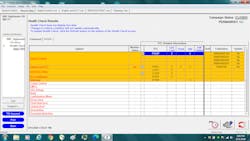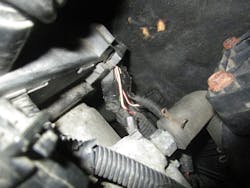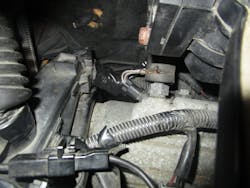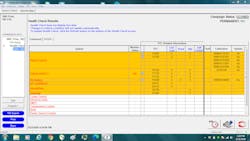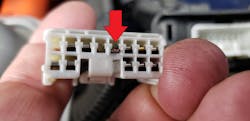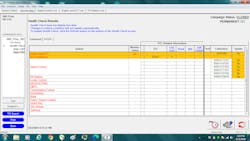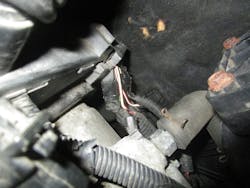
Many technicians may believe that hybrid and fully electrified vehicles are more complicated than gas or diesel-powered ones. Now, they are more complicated; however, there are many basic electrical tests and diagnostic strategies that can be shifted over from the standard 12-volt systems to the high voltage systems. Electricity is electricity, and if you know how to diagnose electrical problems on non-electrified vehicles, you can (with the proper training and equipment) complete a proper diagnosis of hybrid or electrical vehicles.
2007 Toyota Highlander — “no start”
Our first problem vehicletowed in was a 2007 Toyota Highlander Hybrid with 146K miles on the clockand a complaint of a nostart. Upon our basic checks, we found the “Ready”dash HVlight illuminated,but the engine would not run. The Highlander had acrank, no startproblem that could be caused by many different issues, mechanical or electrical. All the dash lights lit up like a Christmas tree, along with the odometer, which displayed the following messages; (video up on www.attstraining.com), Check Hybrid System, Check AWD (All Wheel Drive) System and Check VSC (Vehicle Stability Control)System.Now those are some serious issues that need to be checked out carefully. We needed to contact the shop that towed the vehicle into us so we could find out some background on this no-start issue. The shop responded by saying that the vehicle owner said, “it was running one day but would not run the next.” Since the shop was not sure where to start their diagnosis (because it was a hybrid vehicle), they towed it to us. Some techs get diag-shy when it comes to hybrid/electric vehicles because they may not have the training and the correct equipment. It’s somewhat understandable, but we all need to update our skills or we will be left out in the cold. Today’s shop owners and technicians need to invest in their careers and future, starting with a commitment to getting up to speed in electrical diagnosis followed by investing in hybrid equipment and most importantly hybrid/electric classes. The shop owner (from where this Highlander came) always made excuses that he was too busy to analyze hybrid vehicle problems. Some of you may agree with sending a problem vehicle out to be diagnosed and repaired while you make money doing what you do. Agree or disagree, as shop owners we need to make decisions that work for us. The Highlander did have a check engine light illuminated, which provided a starting point for diagnosis, but the shop decided not to be bothered with the vehicle.
With the Highlander hybrid vehicle in my shop, it was up to us to diagnose the problem. I always say we need a game plan before attacking any problem vehicle. That being said, we performed a quick visual inspection followed by the next best place to start — connecting a scan tool. Our choice, especially when it comes to hybrid/electric vehicles, is using the factory scan tool. Since this vehicle is a Toyota Highlander, we connected the Toyota Techstream then selected Health Report, which performs a full vehicle scan of all the systems. Once the Techstream health check was complete (Figure 1), the results would be analyzed to decide which path to take. The results in order are the following:
1. P0A0F Engine Failed to Start
2. P0351 Ignition Coil "A" Primary/Secondary Circuit
3. C1241 Low or High Power Supply Voltage
4. C1259 HV Control System Regenerative Malfunction
5. B1248 AVC-LAN Communication Impossible
The question is where do you start your diagnosis? In this case, we started by checking the current DTC data first. There were three current DTCs (Figures 2, 3 and 4) that we would check first— P0A0F, P0351 and C1259. We looked up the information and carefully reviewed the descriptions. The first one (P0A0F “Engine Failed to Start”) can be caused by a transaxle input malfunction that I have seen before. One Highlander hybrid vehicle that I diagnosed would not crank due to a seized transaxle. The DTC description goes on to explain the other issues that can cause this DTC. These include engine system problems, transaxle assembly, transmission input damper, wire harness or connectors.
The next DTC was P0351 “Ignition Coil ‘A’ Primary/Secondary Circuit – No. 1 Ignition Coil Circuit Current.” This DTC is easy to diagnosis since it entails checking the ignition coils for spark. The third DTC was C1259 HV Control System Regenerative Malfunction that is caused by skid control ECU communicates with the HV control ECU that controls braking force according to the motor's regenerative force.
The next DTCs, C1241 “Low or High Power Supply Voltage,” can be caused by a power source voltage drop for the skid control ECU or the ABS relays. B1248 “AVC-LAN Communication Impossible” can be due to communication between the AVC-LAN (radio receiver assembly or multi-display assembly) and multiplex network gateway ECU that stops for more than 10 seconds. We placed the last two DTCs that were not coding as “Current” on the back burner.
A good place to start would be checking out the P0351 since it was a current DTC that could cause P0A0F “Engine Failed to Start.” The third code, C1259 “Regen Malfunction,” would be due to the ICE (internal combustion engine) not starting. You can now understand why we went after the P0351 first.
We started using the GTC505 Ignition Tester and found that cylinder No. 1 coil was not working. Our further investigation revealed the problem; it was not a bad coil or plug, but rather a chewed-up coil wire connector (Figure 5). It seemed that a rodent had snacked on the coil wires and connector. We ordered a new connecter and removed the chewed-up wires, then soldered and heat shrank them (Figure 6). Once the repair was completed, we cranked the engine over and it started up immediately. Our next move was to erase the DTCs and test drive the vehicle. The test drive yielded good results with everything operating as designed, along with no DTCs or messages displayed. An easy fix that could have been diagnosed and repaired by the shop who sent us this Highlander hybrid problem vehicle.
2005 Toyota Prius — “Transmission Inop”
The next vehicle came from the same shop with a different problem. The issue on this 2005 Toyota Prius with 236Kmiles on the odometer was that the transmission would not go into any gear. The shop told us that they had replaced the transaxle since the MG 2 (Motor/Generator 2) was burnedout,preventing the vehicle from moving. Once again the Toyota Techstream was connected to this Toyota and came up with the following on the Techstream Health Report (Figure 7):P3000 “Battery Control System”
P3102 “Transmission Control ECU”
P1118 “Coolant Temperature Sensor High for Coolant Storage System”
P0A80 “Replace Hybrid Battery Pack”
P0102 “MAF Sensor”
B1421 “AC Sun Load Sensor Circuit”
B2775 “Interior Verification Abnormal To Theft Deterrent ECU”
B2796 “No Communication Malfunction Immobilizer”
B1260 “Gateway Transmission Control ECU Communication Stop”
Almost all of the DTCs were stored as both “current” and in “history.” With that many DTCs, you must make sure to look at the current and history ones first. The reason to check the current DTCs first is that they are causing a problem right NOW! No matter how the other DTCs are stored, always diagnose current DTCs before moving to the others. Having some background information on the vehicle helped us build a diagnostic path. The shop had told us that this Prius was sitting around for a while, and this was the most likely reason for the P0300 and the HV battery having an issue.
The next important DTC on the list to diagnose would be the transmission P3102 DTC that prevented the vehicle from being shifted out to the park. Bill, my technician, started his diagnosis by looking at the P3102 Freeze Frame data to see if the information would provide a good starting point for this issue (Figure 8). As Bill reviewed the data, he looked up service information on the DTC. The information he found in ALLDATA, ProDemand, Identifix and MotoLogic was not leading him to the root cause of the problem. Bill decided to search iATN, Diag.net and Google and found something that a few vehicle owners had complained about. That information provided Bill with a good starting point so he could research the location and wiring diagram for the transmission interlock control wires.
What Bill uncovered was VD (voltage drop) in a fuse box connector under the hood, near the left strut tower (Figure 9). Look at the fourth pin, upper level from the left to view the voltage drop issue. On the connector end you can also see the problem on pin 4, from the right (Figure 10). We tried to clean the pins and connector end with connector files and chemical cleaner, but they were too far gone. We proved out the connector issue by using two insulation piercing clips and a jumper wire. With the clips attached to the wire at each end of the connector, the vehicle was now able to move in and out of all gear rangers proving out our jumper test on the circuit.
We called the shop and informed them of what we found and explained that the repair would require new terminals on both ends. Since the terminals were not readily available because they were back ordered from the dealer, the shop asked if we could just use the jumper wire rather than replacing the terminals. We repaired the problem connectors by installing a jumper wire as a repair (Figure 11). Bill made up a proper jumper wire that he soldered and heat shrank for a permanent repair.
With the transmission issue out of the way, we were now able to go on to the next problem on the DTC list. Moving on to the P0300 HV battery problem, we performed an HV battery test by selecting the important HV battery PIDS and graphing them as we ran the ICE at a high idle, checking for passing scan data results. Normally we would have to discharge the HV battery first before trying to recharge it, but since this 2005 Prius had been sitting for years, we could skip that step. The results of the HV battery test was not good. It failed and the battery had to be replaced. The shop approved the HV battery replacement, so we ordered a replacement.
While we were waiting for the HV battery to come in, we moved on the P1118 “Coolant Temperature Sensor High.” We found that the coolant sensor wire was disconnected, so Bill reconnected the wire connector and continued checking the HV cooling system. He uncovered dirty, weak coolant/antifreeze and a bad inverter cooling pump. The inverter pump mounting bracket was almost completely rusted away. The inverter pump bracket was so rusted that the pump was no longer mounted to the fender, causing a whining noise. This pump looked to be the original pump that has been on this 2005 Prius since it was built. We ordered a new hybrid circulator pump with a bracket, drained and flushed the coolant from the HV side, followed by installing a new pump and then bleeding the cooling system.
With the new pump installed, we made sure that the ICE cooling system and HV cooling system reached the proper operating temperature before we opened the front bleeder valve (near the inverter) to ensure the system was air free. With all the air removed, we checked for leaks and made sure the data PID for ECT (Engine coolant temperature) was at the correct operating temperature.
Checking the vehicle that was now running well, we moved on to the remaining DTCs. This led us to the P0102 “MAF Sensor” code that we found was due to a connection issue. We cleaned up the connector and reconnected it to the MAF sensor. That cleared that DTC.
The next one we never worry about since every Toyota with a sun load sensor has a code B1421 “AC Sun Load Sensor Circuit.” This DTC is due to indoor lighting (no ultraviolet rays sensed). The next DTC B2775 “Interior Verification Abnormal To Theft Deterrent ECU” may have been set due to the 12-volt battery being weak. We also checked the key fob battery that was found to be inoperative, so we replaced it and got it working. The next DTC B2796 “No Communication Malfunction Immobilizer” would also be traced back to a 12-volt battery issue. Our last DTC, B1260 “Gateway Transmission Control ECU Communication Stop” may have also been due to a 12-volt issue.
We cleared all the DTCs and road-tested the Prius to make sure none of the DTCs reappeared. Now that Toyota was running well after addressing the 12-volt battery, HV battery, inverter pump and bracket, MAF wires and the main issue of the selector shifter not going into gear (Figure 12).
I hope the information on both these problem hybrid vehicles helps you make a game plan in diagnosing and repairing hybrid vehicles.
About the Author

G. Jerry Truglia
Jerry Truglia, also known by "G," is an automotive instructor and author whose work with the US Environmental Protection Agency, Society of Automotive Engineers, National Automotive Service Task Force, Council of Advanced Automotive Trainers, Motor Age and Motor Age Training, Professional Tool and Equipment News, and the not-for-profit Technicians Service Training has made him nationally recognized in the automotive repair industry. G. is an ASE World Class Triple Master Technician Auto, Truck & School Bus, L1, L3, F1, A9, X1 C1. Connect with him at LinkedIn.
